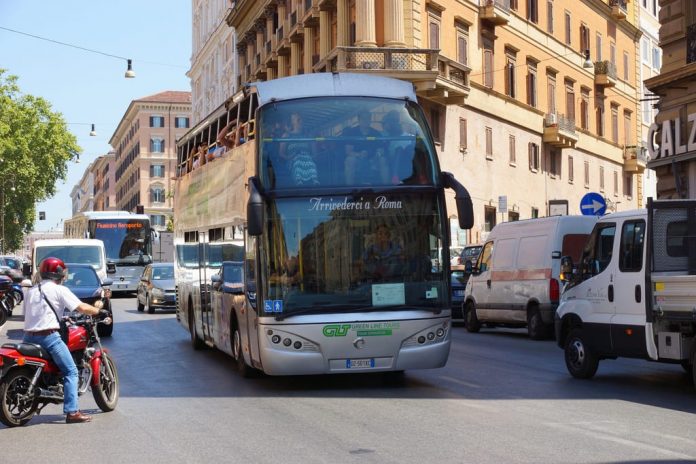Bus tours are popular because they reduce walking and exhaustion while bringing travelers to the doorsteps of popular attractions while handling logistics. But Rome is about to upend that equation with a new regulation aimed at curtailing overtourism, prompting fears among many tour operators that the restrictions will cause tourism businesses to take a hit.
The regulation, set to take effect January 1, will essentially limit where tour buses can go and how many can visit the city center. Roma Mobilità, the city’s transport department, is creating three bus zones with different time restrictions and replacing tour bus annual passes with multi-entry tickets.
The city intends to ease congestion by limiting tour buses in its ancient city center —one of Europe’s most popular destinations — but some tour operators argue the regulation is counterproductive as tour buses hold dozens of people and replace multiple cars.
The regulation was challenged in Rome’s Tribunale Amministrativo Regionale del Lazio court, a regional administrative justice court. The court ruled in the city’s favor on October 12 that the regulation still take effect on January 1, in part to help “reduce pollution and enforce orderly traffic management,” according to a statement from Roma Mobilità.
Rome’s mayor, Virginia Raggi, supports the court’s decision and said the regulation is also meant to reduce carbon emissions in the city. “This is an expected and important decision, which rewards the goodness of our provision and the work done by my administration,” said Raggi, in a statement. “We have, for the first time, approved a series of rigorous rules to protect monuments and valuable areas, to counteract pollution, and to increase road safety. Starting in January, we will have safer roads and a more liveable city.”
Skift wasn’t able to obtain a copy of the suit, but Alessandro Lucio Massari, general manager of Rose Garden Palace in Rome, said the suit was brought by many bus companies and tour operators.
“The new bus regulation is going to change the industry forever,” said Massari. “What’s more complicated is to verify how this new regulation will affect restaurants and sightseeing. Naturally, the cost for the buses to enter Rome will increase a lot.”
Collette, a Rhode Island-based tour operator that runs 17 Italy itineraries, said the regulation will have an adverse effect on tour operators in Italy. “The guests inevitably will bear the burden of changes and costs and this taints the overall travel experience…If tour prices become too expensive, the guests will spend their money in other destinations instead of Rome,” said Paula Twidale, executive vice president of Collette.
Bus companies and tour operators can purchase batches of 50 to 300 daily entry tickets for various prices depending on the vehicle class and fuel type. Under European emissions standards, Euro 5 and 6 vehicles will pay 5 to 10 percent less than Euro 4 vehicles.
Rates for diesel buses, however, will increase 90 percent in 2019 and more than 100 percent in 2020
“We were already planning to go to electric coaches in five years,” said Steve Perillo, CEO of New Jersey-based Perillo Tours, one of the largest tour operators bringing U.S. travelers to Italy.
Perillo doesn’t expect much of a negative impact from the regulation and said Rome, Venice, and Florence already have entrance fees for tour buses. “It’s not going to hurt us too much but it will raise the prices,” he said. “Fees going into the historic district have been going up for years. The distances from buses to sites are getting longer.”
Perillo said he shares the city’s desire to reduce traffic congestion but pointed out that, on average, one tour bus replaces three cars. “I think [Rome] is pushing for more public transportation,” he said. “All of the hotels that we use aren’t affected. But for those that are, they’ll be in trouble. We go to restaurants in that area. We might need to change when we go to the Vatican or some restaurants. Even if we want to pay more, we can’t.”
Turismoroma, the city’s tourism board, wouldn’t comment on the regulation or lawsuit and referred all questions to Roma Mobilità, which didn’t respond to Skift’s request for comment before publication.
Rome, which had nearly 10 million international visitors in 2017, is not the first city to implement this kind of tour bus regulation. San Francisco earlier this year banned tour buses from driving up the street made famous in the 1990s sitcom “Full House” because of traffic and noise. But San Francisco took a much narrower approach, and Rome has targeted a swath of the city that will likely give tour operators – and travelers – headaches come the new year.


























